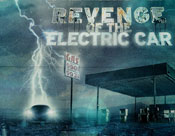Revenge Documentary Creates Character Convergence
One of the joys of teaching editing for 18 years at the nation’s top documentary program is seeing wave after wave of graduating alumni go on to produce world-class documentaries.
Last week I had the privilege of attending the theatrical release of one of my former student’s films, “Revenge of the Electric Car,” which illustrates a storytelling device that can help catapult your own character-driven documentary into the big leagues.
I call this device “character convergence”.
But first, a quick correction. My recent newsletter mis-identified the director of “Wasteland”, which was actually directed by the talented Lucy Walker. Thank you, Lucy, for a fantastic film.
Now back to “character convergence”. First, let’s define it.
Character convergence is when the story arcs of multiple protagonists dovetail into a single event, usually late in your film. This union generally causes the audience to sit up a little straighter, breathe a little faster, and stay glued to the screen.
Some great examples of character convergence include the national spelling bee scene in “Spellbound”, the final dance contest in “Mad Hot Ballroom”, and the car show scene in “Revenge of the Electric Car”.
Directed by Chris Paine and co-produced (along with P.G. Morgan) by my former student, Jessie Deeter, “Revenge of the Electric Car” (www.revengeoftheelectriccar.com) is a sequel to the wonderful essay-style expose, “Who Killed the Electric Car?”
The new film follows three main protagonists (plus a fourth outsider character) who race to be the first to bring a new line of electric cars to the mass market. (Note that four is the maximum number of protagonists that most viewers can follow.)
The first protagonist, dubbed “Rocket Man”, is the young CEO of Tesla Motors. The second protagonist, “Mr. Detriot”, is the GM executive who led the creation of the Volt. And the third protagonist, dubbed “The Warrior”, is the CEO of Nissan, who wants to capture the world market with the Leaf electric vehicle.
In a fascinating convergence scene late in the film, Rocket Man “runs into” Mr. Detroit at a car show. The two rivals decide to check out together the masterpiece of their third rival, the Nissan Leaf vehicle.
Watching the fascinating interaction of these two powerful rivals, I wondered if the film’s producers had arranged the crucial junction of character arcs.
Fortunately, producer Jessie Deeter (my former student who is now an accomplished producer) was on hand after the screening for a Q&A.
Deeter said that once they learned that the Telsa CEO would be attending the show, they alerted the GM executive about the possibility of the two rivals meeting up. After informing each man of the other’s schedule, the producers then decided it was hands-off time.
Camera crews followed each protagonist at the show and caught the spontaneous moment when the two rivals ran into one another.
Their interaction was unscripted, unrehearsed, and marvelously captivating.
The decision about how much to contrive such a convergence of character arcs can be a controversial one.
In general, the cinéma vérité tradition promotes a hands-off approach, but today more and more filmmakers are understanding the narrative appeal of helping bring characters together.
You’ll find an in-depth tutorial on how to craft a documentary with multiple protagonists in “The Ultimate Guide to Structuring Your Documentary”. Learn more about how to structure multiple plot lines at https://newdocediting.com/products/.
